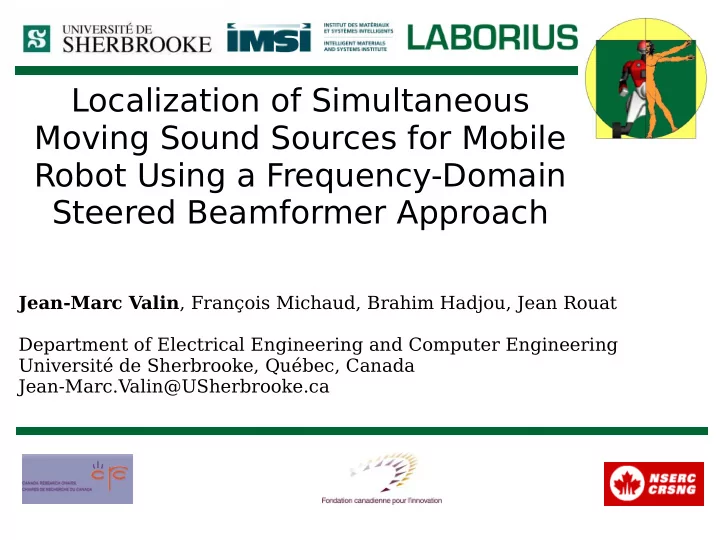

Localization of Simultaneous Moving Sound Sources for Mobile Robot Using a Frequency-Domain Steered Beamformer Approach Jean-Marc Valin , François Michaud, Brahim Hadjou, Jean Rouat Department of Electrical Engineering and Computer Engineering Université de Sherbrooke, Québec, Canada Jean-Marc.Valin@USherbrooke.ca
Approaches to Sound Source Localization Binaural audition T wo microphones Interaural phase difgerence Interaural intensity difgerence Imitate human auditory system Microphone array audition Larger number of microphones Phase difgerence only Increased redundancy compensating for high complexity of human audition
Approach Overview Sounds arrive at microphones with difgerent delays (depending on distance) Hypothesis: point sound sources Steered beamformer: scans all directions for energy peaks Probabilistic post-processing: applies Bayesian inference
Steered Beamformer Delay-and-sum beamformer Beamformer energy
Frequency Domain Computation
Spectral Weighting Cross-correlation peaks are very wide Poor angular accuracy Overlap between close sources Solution: spectral weighting Whiten spectrum Give less weight to noisy regions of spectrum
Search Set of possible directions of arrival represented as sphere Defjning a homogeneous grid Recursive subdivision of icosahedron Resulting grid with 2562 points
Search Find directions with highest energy
Bayesian Post-fjlter Data from beamformer is noisy Express localization in terms of source probability of presence Probability computed for each grid point Use Bayes' rule to compute probability using past and present observations
Bayesian Post-fjlter beamformer probability a priori probability combined probability
Estimator Combination All previous steps computed twice Short frames (~40 ms) Medium frames (~200 ms) Need to combine both estimators Estimators are not independent Weighted geometric average of the dependent case and the independent case:
Results Detection accuracy over distance Difgerent sounds Rate of detection(#detections / #occurences)
Results (2 moving speakers) azimuth time
Results (2 moving speakers) azimuth time
Results (4 moving speakers) azimuth time
Results (moving robot) Localization in 3D azimuth elevation time
Conclusion Robust localization of sound sources Moving sources or robot Up to 4 simultaneous sources reliably Reliable detection up to 5 meters T wo-step method Steered beamformer Bayesian post-fjlter Related work T racking sources over time one mic separated Separating sound
Questions?
Search (cont.) 1) Steered beamformer direction search Finding the direction with highest energy
Bayesian Post-fjlter (cont.) Beamformer assigns instantaneous probability for each grid point A priori probability assuming a Markov process Current probability
Results (7 sources)
Search (cont.) 2) Complete search Finding all sources
Recommend
More recommend